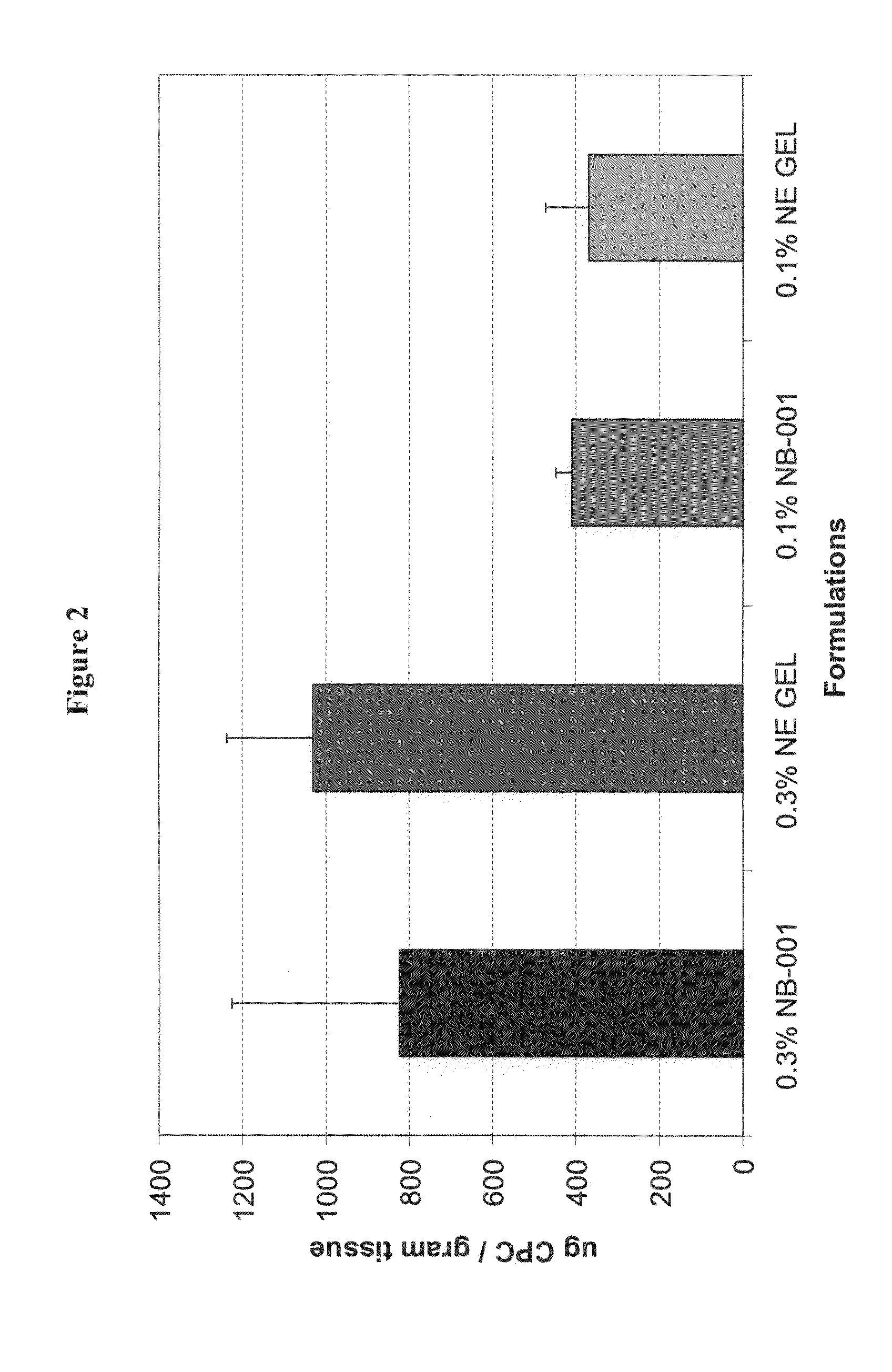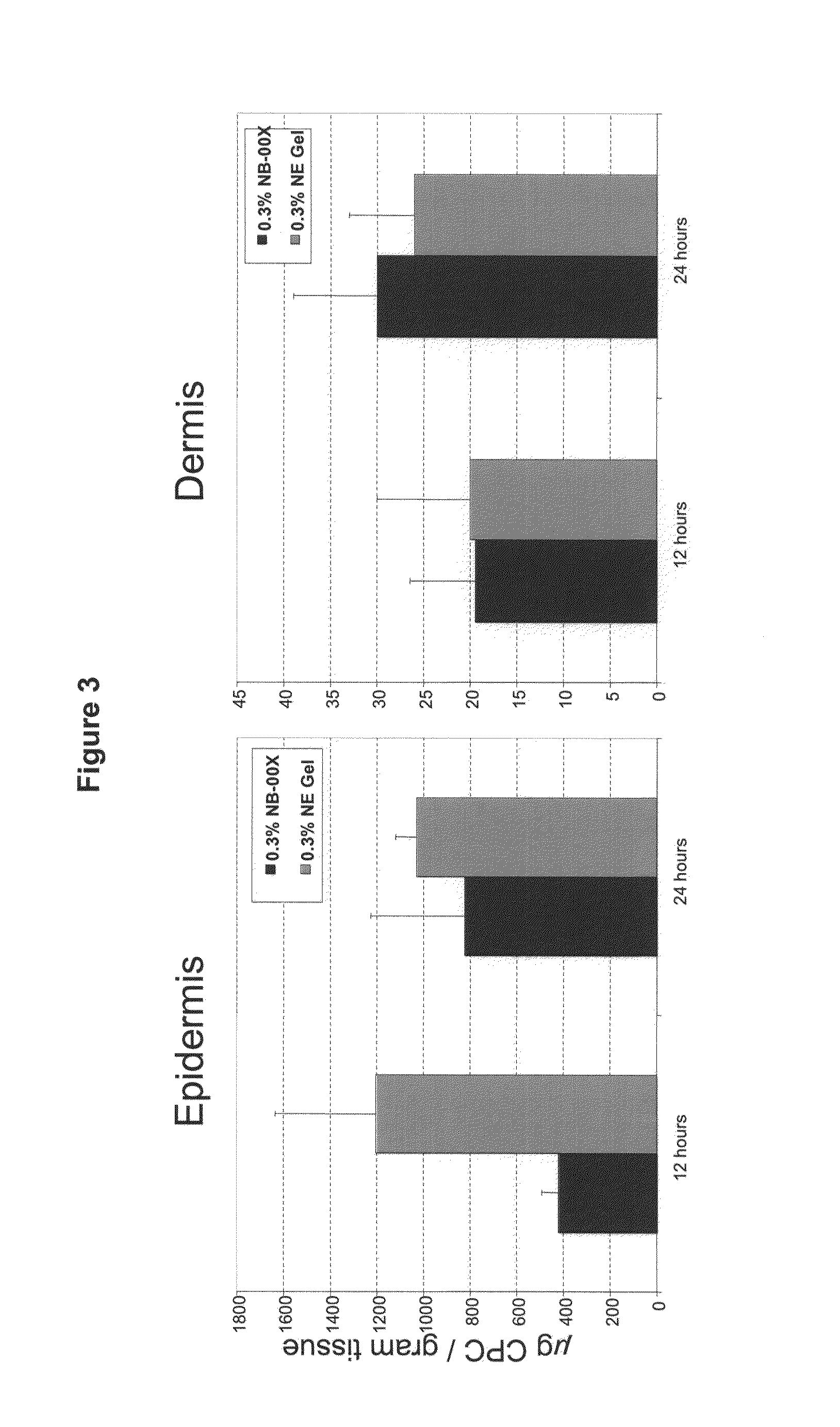Compositions for treatment and prevention of acne, methods of making the compositions, and methods of use thereof
a technology for acne and compositions, applied in the field of compositions for acne treatment and prevention, can solve the problems of drug resistance or other undesirable side effects, obstructing the hair follicle, and subsequent accumulation of lipids and cellular debris, so as to reduce the potential for resistance development, improve the efficacy and or tolerability of the second anti-acne agent, and improve the effect of delivery and control
- Summary
- Abstract
- Description
- Claims
- Application Information
AI Technical Summary
Benefits of technology
Problems solved by technology
Method used
Image
Examples
example 1
Preparation of Nanoemulsions
[0123]These emulsions are produced by mixing a water-immiscible oil phase into an aqueous phase with a proprietary manufacturing method. The two phases (aqueous phase and oil phase) are combined together and processed to yield an emulsion. The emulsion is further processed to achieve the desired particle size. For the gel formulation, a thickening agent, such as Klucel can be added to the nanoemulsion. For example, Klucel is dissolved in water or any aqueous solvent and added to the nanoemulsion to achieve the desired concentration.
example 2
The Nanoemulsions have Potent Activity Against P. acnes
[0124]Nanoemulsions according to the invention were tested in in vitro to determine the minimum inhibitory concentration (MIC) and minimum bactericidal concentration (MBC) against 16 clinical isolates of P. acnes, some of which have defined ribosomally-based resistance mechanisms to erythromycin, clindamycin and / or tetracycline. The nanoemulsions (“NB-00X”) comprised, in an aqueous medium, soybean oil, Tween 20® as a nonionic surfactant, ethanol, cetylpyridinium chloride (CPC) as a cationic surfactant, EDTA, and water, and optionally, a thickening agent for the gel formulation.
TABLE 3Compositions of the Nanoemulsions (NB-00X) and Nanoemulsion Gels (NB-Gel).The percentages are wt / wt, unless otherwise noted.LotSoybeanTween 20EthanolCPCEDTAKlucelWaterFormulation#oil %%%% (w / v)%%%0.1% NB-00X89-16-09A6.2790.5920.6790.1070.0074092.340.3% NB-00XX-116018.8371.7762.0370.3200.022077.010.1% NB-Gel89-16-09C6.2790.59220.6790.1070.00741%92.3...
example 3
The Nanoemulsions have Potent Activity Against P. acnes in the Presence of Sebum
[0142]Nanoemulsions according to the invention were tested in in vitro antibacterial assays in the presence of 50% artificial sebum to determine the minimum inhibitory concentration (MIC) and minimum bactericidal concentration (MBC) against 16 clinical isolates of P. acnes. The nanoemulsions (“NB-002”) comprised, in an aqueous medium, soybean oil, Tween 20® as a nonionic surfactant, ethanol, cetylpyridinium chloride (CPC) as a cationic surfactant, EDTA, and water.
TABLE 5Composition of NB-00X formulationsSoybeanTween 20CPC %EDTAKlucelWaterFormulationLot #oil %%Ethanol %(w / v)%%%0.1% NB-00X89-16-09A6.2790.5920.6790.1070.0074092.340.3% NB-00XX-116018.8371.7762.0370.3200.022077.010.1% NB-Gel89-16-09C6.2790.59220.6790.1070.00741%92.340.3% NB-Gel89-702518.8371.77622.0370.3200.0221%77.01
[0143]The source of drugs and isolates were the same as in Example 2. 100X drug stocks were prepared as in Example 2.
[0144]A. P...
PUM
 Login to View More
Login to View More Abstract
Description
Claims
Application Information
 Login to View More
Login to View More - R&D
- Intellectual Property
- Life Sciences
- Materials
- Tech Scout
- Unparalleled Data Quality
- Higher Quality Content
- 60% Fewer Hallucinations
Browse by: Latest US Patents, China's latest patents, Technical Efficacy Thesaurus, Application Domain, Technology Topic, Popular Technical Reports.
© 2025 PatSnap. All rights reserved.Legal|Privacy policy|Modern Slavery Act Transparency Statement|Sitemap|About US| Contact US: help@patsnap.com



